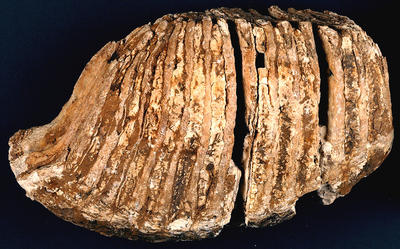
A woolly mammoth tooth found at Kenmuir Hill, Mount Vernon. It is probably a second molar from a mammoth which lived between 14,500 and 13,000 years ago during the Late Glacial period.
Woolly mammoths are extinct members of the elephant family and research on DNA from frozen remains found in Siberia has shown that they were closely related to modern Indian elephants. They were covered in a dense fur to keep them warm - hence the name woolly mammoth - and both males and females had tusks. Their teeth had adapted to graze on grass and analyses of the stomach contents of frozen mammoths have shown that grass made up most of their diet, supplemented with twigs from trees and shrubs.
Woolly mammoths became extinct around the end of the Ice Age. Scientists believe that this was partly because they could not cope with warmer conditions and partly because humans hunted them for food.
Reference: G.1959.108
Reproduced with the permission of Glasgow City Council, Glasgow Museums
Keywords:
archaeology, DNA, extinct animals, geology, hunting, Ice Age, Kenmuir Hill, Late Glacial period, teeth, woolly mammoths
You have 0 images in your photo album.